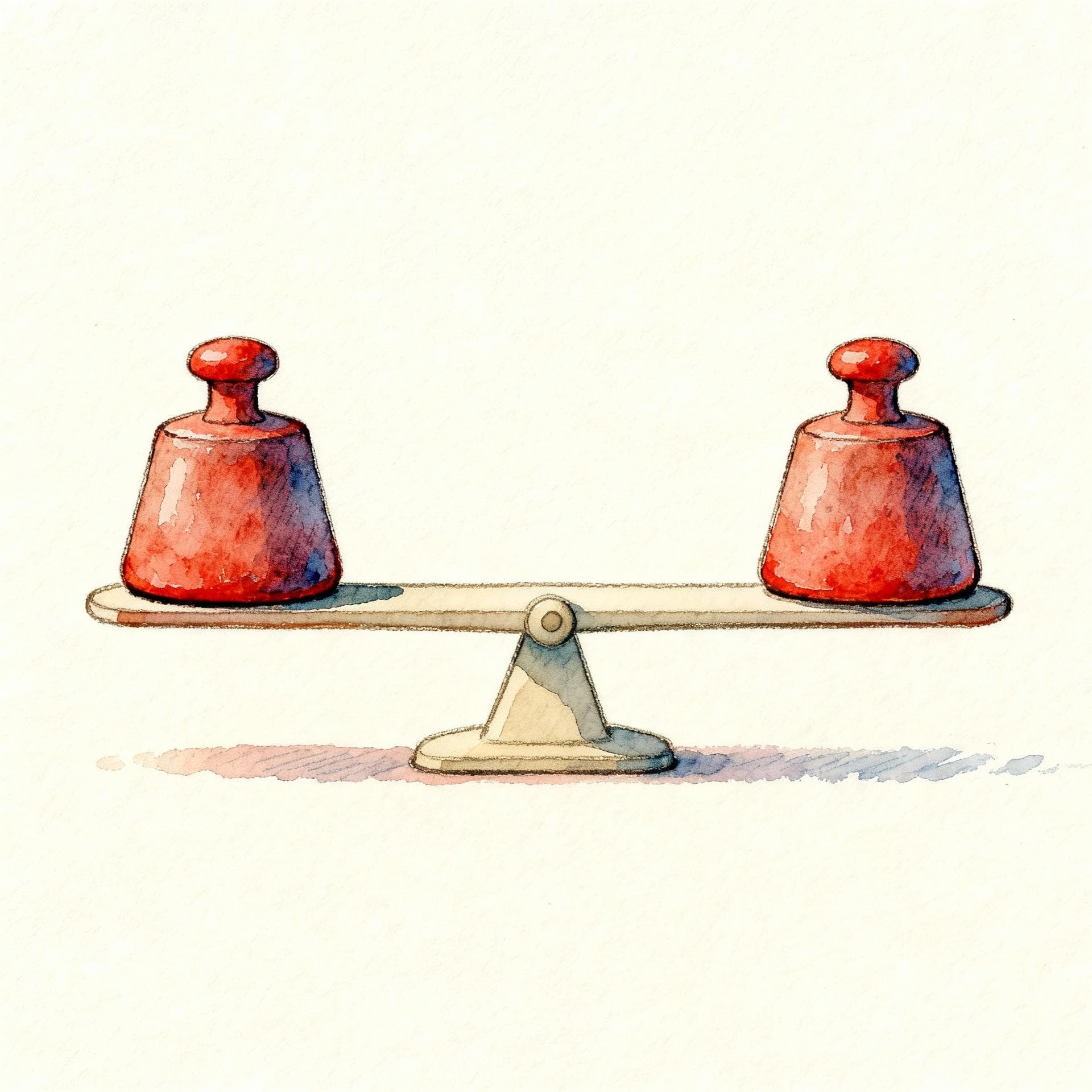Table of Contents
Spanish Comparisons: A Complete Guide to Más Que, Menos Que & Tan Como
Is Spanish more romantic than French? Is a gatocat as smart as a perrodog? Is this guide the best way to learn Spanish comparisons? (We think so!)
Being able to compare things is a superpower in any language. It lets you express your opinions, describe the world around you, and make choices—from picking a movie to deciding which city to visit.
In Spanish, making comparisons is surprisingly simple once you learn a few key formulas. In this guide, we'll break down the three essential structures you need to know:
más ... que(more ... than)menos ... que(less/fewer ... than)tan ... como(as ... as)
Ready to start comparing like a pro? ¡Vamos!

Making Things Unequal: Comparisons with Más and Menos
When you want to say that two things are not equal, you'll use más (more) or menos (less). Think of these as the building blocks for saying something is bigger, smaller, faster, or slower than something else.
The basic formula is straightforward:
Subject + Verb + más/menos + [Adjective/Adverb/Noun] + que + Object
Let's see how this works in different situations.
Comparing with Adjectives (Describing Words)
This is the most common type of comparison. You're simply saying one thing has more or less of a certain quality than another.
Formula: más/menos + adjective + que
- Mi coche es más rápido que tu coche.
- My car is faster than your car.
- Barcelona es menos grande que Madrid.
- Barcelona is less big than Madrid.
- Estas manzanasapples son más rojas que esas.
- These apples are redder than those ones.
Don't Forget Agreement!
Remember, the adjective must still agree in gender and number with the first noun you're describing. Notice how rojo becomes rojas to match manzanas in the example above!
Comparing with Adverbs (Describing Actions)
You can also compare how actions are performed. Do you speak more quickly than your friend? Does the sun shine less brightly in winter?
Formula: más/menos + adverb + que
- Hablo español más despacio que mi profesor.
- I speak Spanish more slowly than my teacher.
- Mi hermanobrother come menos ruidosamente que yo.
- My brother eats less noisily than I do.
- Ella trabaja más eficientemente que su colega.
- She works more efficiently than her colleague.
Comparing with Nouns (Counting Things)
Want to say you have more books or less time? You can also use más and menos to compare quantities of things.
Formula: más/menos + noun + que
- Tengo más libros que María.
- I have more books than María.
- En mi ciudadcity, hay menos árboles que en la tuya.
- In my city, there are fewer trees than in yours.
- Ella necesita más tiempo que nosotros para terminar.
- She needs more time than us to finish.
How would you say 'I have less money than you'?

The Rebels: Irregular Comparatives
Just like English has "good, better, best" instead of "good, gooder, goodest," Spanish has a few common words that refuse to follow the más/menos rule. Memorizing these four rebels will make you sound much more natural.
| Adjective | English | Irregular Comparative | English |
|---|---|---|---|
| bueno/a | good | mejor | better |
| malo/a | bad | peor | worse |
| grande | big/old | mayor | bigger/older |
| pequeño/a | small/young | menor | smaller/younger |
Drag the handle to compare
Let's look at some examples:
- Tu idea es mejor que mi idea.
- Your idea is better than my idea.
- El climaweather hoy está peor que ayer.
- The weather today is worse than yesterday.
- Mi hermana es mayor que yo.
- My sister is older than me.
- Tu perro es menor que el mío.
- Your dog is younger than mine.
Mayor/Menor vs. Más Grande/Más Pequeño
This is a tricky one!
- Use
mayorandmenorprimarily when talking about age. - Use
más grandeandmás pequeñowhen talking about physical size.
- Age: Mi abuelo es mayor que mi abuela. (My grandpa is older than my grandma.)
- Size: Mi casa es más grande que tu apartamento. (My house is bigger than your apartment.)

Keeping Things Equal: Comparisons with Tan... Como
What if things are the same? To say something is "as ... as" something else, you'll need the dynamic duo: tan and como.
Using Tan with Adjectives & Adverbs
When you're comparing qualities (adjectives) or the way actions are done (adverbs), you'll use tan.
Formula: tan + adjective/adverb + como
- El libro es tan interesante como la película.
- The book is as interesting as the movie.
- Mi cochecar es tan rápido como el tuyo.
- My car is as fast as yours.
- ¿Puedes hablar tan despacio como yo?
- Can you speak as slowly as I do?
Tan Never Changes!
Easy rule to remember: tan is a constant. It never changes for gender or number. It's always just tan.
Using Tanto with Nouns
When you want to say "as much" or "as many," tan gets a little bigger and becomes tanto. This version does change to match the noun it's describing.
Formula: tanto/a/os/as + noun + como
- tanto (+ masculine singular noun): No tengo tanto tiempo como tú. (I don't have as much time as you.)
- tanta (+ feminine singular noun): Ella tiene tanta paciencia como un santo. (She has as much patience as a saint.)
- tantos (+ masculine plural noun): Tengo tantos amigos como mi hermano. (I have as many friends as my brother.)
- tantas (+ feminine plural noun): Compramos tantas manzanas como naranjas. (We bought as many apples as oranges.)
Which is the correct way to say 'He has as many books as I do'?
Watch Out! Common Stumbling Blocks
Learning comparisons is a huge step, but there are a few common traps. Let's look at how to avoid them.
1. Forgetting que or como
It's easy to drop the second half of the comparison pair. Remember, más and menos almost always need a que, and tan/tanto need a como.
Drag the handle to compare
2. Mixing Up tan and tanto
This is the most frequent mistake. Just remember this simple rule:
tan+ adjective/adverb (describing words)tanto/a/os/as+ noun (things you can count)
3. Comparing with Numbers: Más de
Here's a special rule that often trips up learners. When you are comparing something to a specific number, you don't use que. You use de.
Use más de / menos de + NUMBER
- Tengo más de veinte euros en mi cartera.
- I have more than twenty euros in my wallet. (Here you are comparing "my euros" to the number "twenty").
- La viajetrip dura menos de tres horas.
- The trip takes less than three hours.
Compare this to a normal comparison:
- Tengo más dinero que tú. (Comparing money to money, not a number).
Quick Rule: `Que` vs. `De`
- Use
quewhen comparing two things, people, or actions. - Use
dewhen the comparison is followed by a specific number.
Time to Practice!
Let's put your new knowledge to the test.
Exercise 1: Choose the Right Word
Fill in the blank with the correct word: más, mejor, tan, tanto, or tantos.
- Mi perro es ______ inteligente que tu gato.
- Este examen es ______ que el anterior. ¡Fue muy difícil! (worse)
- No tengo ______ dinero como para comprar ese coche.
- Mi apartamento no es ______ grande como tu casa.
- ¿Por qué tienes ______ zapatos?
Click to see the answers
1. más (regular comparison with an adjective)
2. peor (irregular for "malo")
3. tanto ("dinero" is a masculine singular noun)
4. tan ("grande" is an adjective)
5. tantos ("zapatos" is a masculine plural noun)
Exercise 2: Build the Sentence
Put these words in the correct order to form a comparative sentence.
Arrange the words to form a correct sentence:
Arrange the words to form a correct sentence:
Conclusion
You've done it! You now have the essential tools to make all kinds of comparisons in Spanish. Whether you're debating if tacos are mejor que burritos, explaining that your city has tantos museos como a capital, or admitting you need más café, you're ready.
Like any new skill, the key is practice. Start looking for opportunities to compare things in your daily life. Is your coffee today más caliente que yesterday's? Is this lesson tan útil como you hoped? The more you use these structures, the more natural they'll become.
¡Buena suerte!